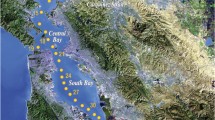Abstract
In 2000, Florida’s fast-growing hard clam aquaculture industry became eligible for federal agricultural crop insurance through the US Department of Agriculture, but the responsibility for identifying the cause of mortality remained with the grower. Here we describe the continuous water quality monitoring system used to monitor hard clam aquaculture areas in Florida and show examples of the data collected with the system. Systems recording temperature, salinity, dissolved oxygen, water depth, turbidity and chlorophyll at 30 min intervals were installed at 10 aquaculture lease areas along Florida’s Gulf and Atlantic coasts. Six of these systems sent data in real-time to a public website, and all 10 systems provided data for web-accessible archives. The systems documented environmental conditions that could negatively impact clam survival and productivity and identified biologically relevant water quality differences among clam aquaculture areas. Both the real-time and archived data were used widely by clam growers and nursery managers to make management decisions and in filing crop loss insurance claims. While the systems were labor and time intensive, we recommend adjustments that could reduce costs and staff time requirements.
Similar content being viewed by others
References
Arnold, W. S., Marelli, D. C., Bert, T. M., Jones, D. S., & Quitmeyer, I. R. (1991). Habitat-specific growth of hard clams Mercenaria mercenaria (L.) from the Indian River, Florida. Journal of Experimental Marine Biology and Ecology, 147, 245–265.
Baker, S. M., Baker, P., Heuberger, D., & Sturmer, L. (2005). Short-term effects of rapid salinity reduction on seed clams (Mercenaria mercenaria). Journal of Shellfish Research, 24, 29–33.
Bayne, B. L. (1993). Feeding physiology of bivalves: time-dependence and compensation for changes in food availability. In R. F. Dame (Ed.) Bivalve filter feeders in estuarine and coastal ecosystem processes (pp. 1–23). New York: Springer.
Bisker, R., & Castagna, M. (1985). The effect of various levels of air-supersaturated seawater on Mercenaria mercenaria (Linné), Mulina lateralis (Say), and Mya arenaria Linné, with reference to gas bubble disease. Journal of Shellfish Research, 5, 97–102.
Castagna, M., & Chanley, P. (1973). Salinity tolerance of some marine bivalves from inshore and estuarine environments in Virginia waters on the western mid-Atlantic coast. Malacologia, 12, 47–96.
Castagna, M., & Kraeuter, J. N. (1981). Manual for growing the hard clam Mercenaria. Special report in: Applied Marine Science and Ocean Engineering No 249.
Chanley, P. E. (1958). Survival of some juvenile bivalves in water of low salinity. Proceedings of the National Shellfisheries Association, 48, 52–65.
Hamwi, A. (1969). Oxygen consumption and pumping rate of the hard clam Mercenaria mercenaria L. Dissertation, Rutgers University, New Brunswick, New Jersey.
Murphy, R. C. (1985). Factors affecting the distribution of the introduced bivalve, Mercenaria mercenaria in a California lagoon – the importance of bioturbation. Journal of Marine Research, 43, 673–692.
Philippakos, E., Adams, C., Hodges, A., Mulky, D., Comer, D. & Sturmer, L. (2001). Economic Impact of the Florida Cultured Hard Clam Industry. Technical Paper SGR 123, Florida Sea Grant College Program, Gainesville, FL, 23 pp.
Phlips, E. J., & Bledsoe E. L. (2002). The consequences of Suwannee River eutrophication on the dynamics of algae in the river and associated estuary. Report to Suwannee River Water Management District, Live Oak, Florida.
Shumway, S. E. (1996). Natural environmental factors. In V. S. Kennedy, R. I. E. Newell, & A. F. Eble (Eds.) The eastern oyster, crassostrea virginica (pp. 467–513). College Park, Maryland: Maryland Sea Grant College.
Small, T. A. (2005). CDMO NERR SWMP Data Management Manual, Version 5.2. Prepared for the NERR System-wide Monitoring Program.
Tedesco, M., Bolen, W. F., Howard-Strobel, M. M., Cohen, D. R., & Tebeau, P. A. (2003). The MYSound Project: building and estuary-wide monitoring network for Long Island Sound. U.S.A. Environmental Monitoring and Assessment, 81, 35–42.
Trueblood, D. D., & Kranz, R. (1998). Ecological monitoring in the National EstuarineResearch Reserve System. US Dep. Commerce, NOAA, NOS, OCRM. Silver Spring, MD.
Wenner, E. L., & Geist, M. (2001). The National Estuarine Research Reserves Program to monitor and preserve estuarine waters. Coastal Management, 29, 1–17.
USDA (United States Department of Agriculture). (1990). ‘Aquaculture: Florida Aquaculture Sales Total $51 Million in 1989. National Agricultural Statistics Service, Florida Field Office.
USDA (United States Department of Agriculture). (2000a). Aquaculture: Florida Aquaculture Sales Total $86 Million in 1999. National Agricultural Statistics Service, Florida Field Office.
USDA (United States Department of Agriculture). (2000b). Cultivated Clam Pilot Crop Insurance Underwriting Guide. Federal Crop Insurance Corporation, Product Development Division: FCIC-24100.
USDA (United States Department of Agriculture). (2006a). 2002 Census of Agriculture, Census of Aquaculture (2005). National Agricultural Statistics Service:, Volume 3, Special Studies Part 2, AC-02-SP-2.
USDA (United States Department of Agriculture). (2006b). Aquaculture: Florida Aquaculture Sales Total $75 Million in 2005. National Agricultural Statistics Service, Florida Field Office.
Author information
Authors and Affiliations
Corresponding author
Rights and permissions
About this article
Cite this article
Bergquist, D.C., Heuberger, D., Sturmer, L.N. et al. Continuous water quality monitoring for the hard clam industry in Florida, USA. Environ Monit Assess 148, 409–419 (2009). https://doi.org/10.1007/s10661-008-0171-3
Received:
Accepted:
Published:
Issue Date:
DOI: https://doi.org/10.1007/s10661-008-0171-3




